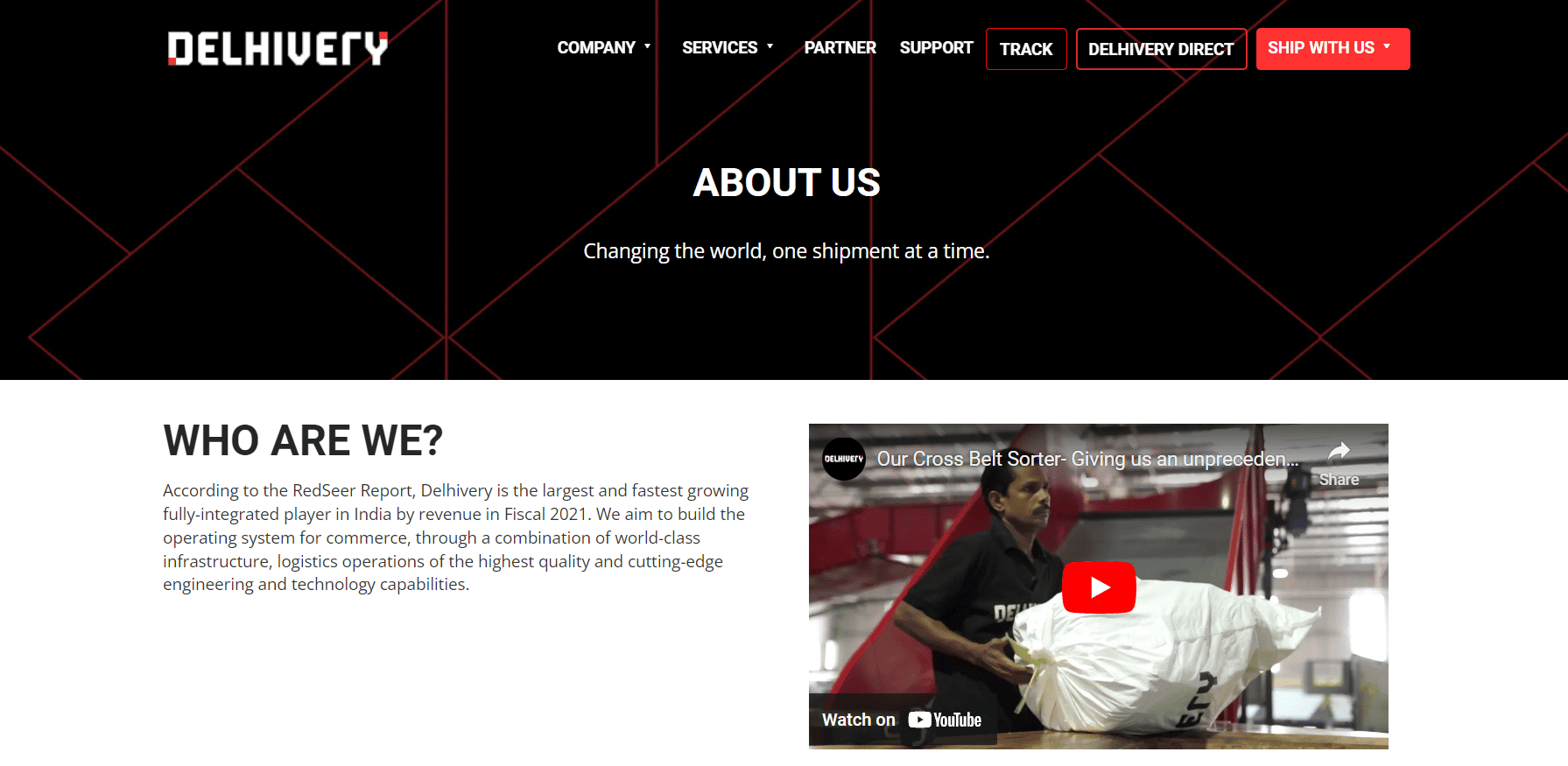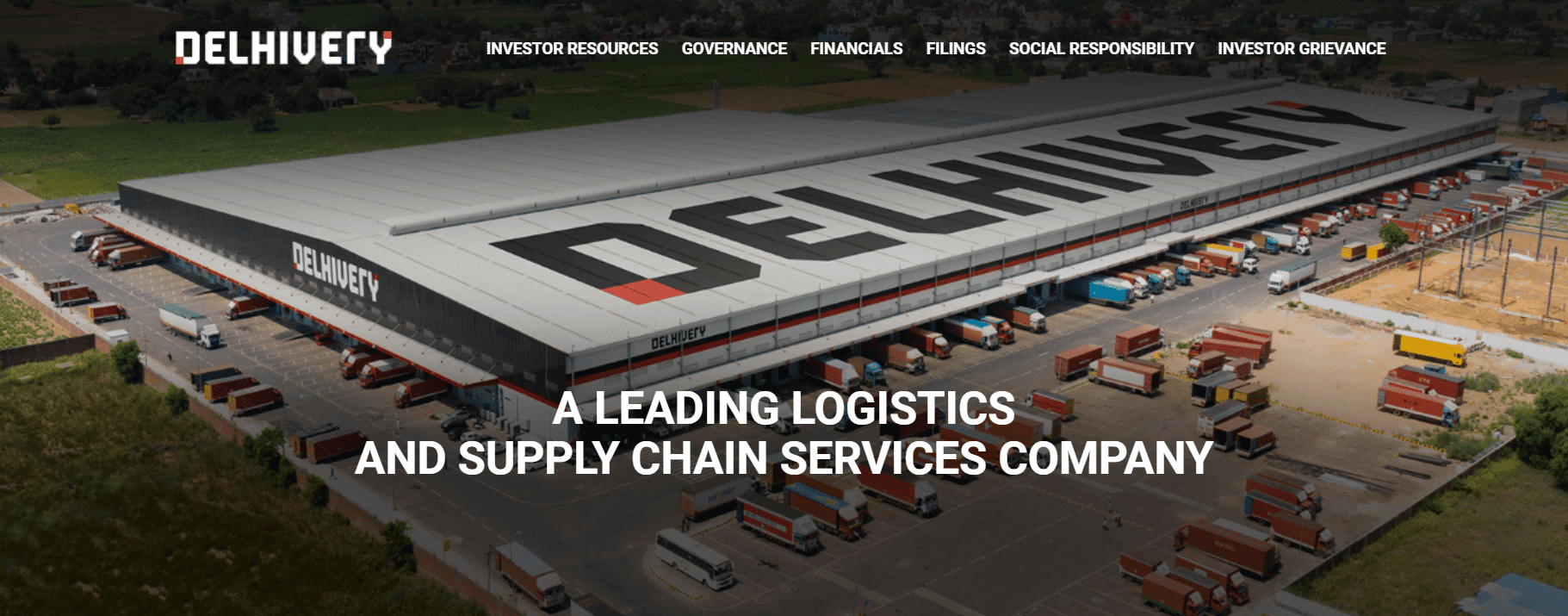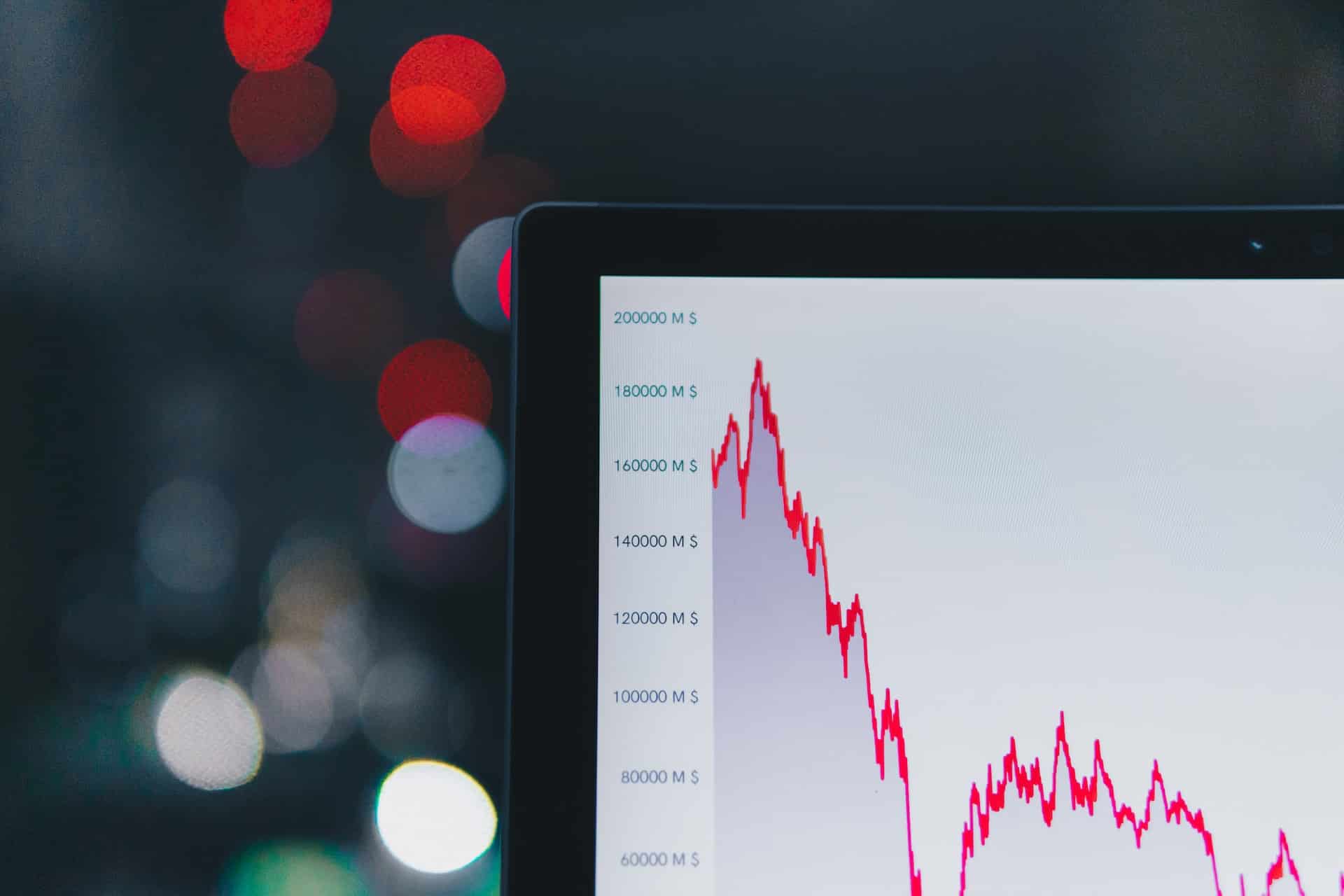Delhivery IPO Valuation, Date, Share Price
Even though logistics has always been a crucial industry for any nation, including India, the sector has never undergone such a revolutionary change until Delhivery was founded. This business, which has been demonstrating its value as a startup since 2011, is now one of the core pillars of the logistics sector in India. Before we learn about their valuation and Delhivery IPO Prospectus, let us understand what the company does.
About Delhivery
Delhivery was established in May 2011 and has its headquarters in Gurugram, Haryana. The company currently offers a variety of services, such as last-mile delivery, transit, third-party warehousing, reverse vendor-to-warehouse shipping, logistics, payment collection, vendor-to-customer shipping, and more. They work on providing the best services to the clients by focusing on three main points; data services, omnichannel and fulfilling services. It offers goods and services designed to foster trust and enhance the quality of life for customers, small companies, enterprises, and their expanding teams of partners and workers. Delhivery’s 29,000+ clients benefit from unmatched cost-effectiveness and pan-India coverage. Delhivery’s vision is to reduce time and distance, and this drives its goal of reducing distance for its clients. It is one of the country’s top participants in the logistics sector right now. Times Internet Ltd., which purchased a minority investment in the company in June of last year, is the company’s backer. When it received $413 million in a Series F round headed by Carlyle Group, SoftBank Vision Fund, and Fosun International in 2019, Delhivery became a unicorn. At that time, it was worth $1.5 billion. In May 2022, the firm was valued at $4.77 billion before Delhivery ipo valuation.
Founder Team
A group of engineers, including Kapil Bharati, Mohit Tandon, Bhavesh Manglani, Sahil Barua, and Suraj Saharan, founded Delhivery. Kapil Bharati is the CTO other than being one of the co-founders. He earned his Btech in Mechanical Engineering from IIT Delhi. After working for the Hindustan Times, Bharati joined SapientNitro. Before Delhivery, Bharati co-founded two additional businesses, 11Rupees and Contify.com. Sahil Barua, the co-founder, and CEO of Delhivery studied BE Mechanical Engineering at NIT Karnataka and was a Bain & Company consultant. IIT Kanpur graduate Mohit Tandon joined Bain & Company following his undergraduate studies. Before joining hands with others in creating Delhivery, he worked as a consultant for 5 years. Another co-founder of Delhivery, Bhavesh Manglani, quit the business on March 29, 2021. Suraj Saharan, also a former consultant for Bain & Company, began his career as a manager of the customer service for ICICI Lombard before helping to launch Delhivery. Saharan is a graduate of IIT Bombay, where he earned a B.Tech in mechanical engineering.
Performance of Delhivery in 2021
Last year, the company boasted of major growth in terms of clients, team, and revenue. They reported around 60,000 employees working in different departments of the firm. They also stated that it can process more than 15 lakh (about 1.5 million) packages daily in 2,300 towns and cities and 17,500 pin codes in India. Also, to foster collaboration and employee effectiveness, the business wants each employee to spend at least 12 hours a week working as a delivery boy. Massive deliveries are made possible by its network of more than 5,000 vehicles and close to 7,000 drivers. In addition, Delhivery is constructing some of the biggest trucking terminals in the nation in prominent cities including Delhi, Mumbai, Bangalore, Hyderabad, Kolkata, and Chennai. The business has a nationwide network of more than 85 packaging warehouses. Also, they have over 8,000 partner centers and automated hub centers.
Delhivery Financials and Funding
In Q1 FY23, Delhivery’s consolidated net loss increased by 208% YoY at Rs. 399.3 crore. Losses from the Delhivery increased by 233% QoQ and totaled Rs. 119.8 crores. The reported income for Delhivery in Q1 FY23 was Rs. 1794.5 crore, up 31% year over year but down 15.6% from Rs. 2172 crore in Q4 FY22. On the other hand, Delhivery’s overall costs increased by more than 48% YoY to Rs. 2205.7 crore in the same period. The company states that it had a revenue of Rs. 3700 crore in FY21, up from Rs. 2800 crore in FY2020, and it expects to achieve Rs. 6000 – Rs. 7000 crore during the following two years. Operating income increased from Rs. 2780.5 crore in FY20 to Rs. 3646.5 crore in FY21. In total, Delhivery has raised $1.69 billion in investment across 15 rounds. Before its initial public offering (IPO) on May 11, 2022, the firm obtained a capital round of $303.73 million that was led by 64 anchor investors, including Steadview, Tiger Global, Bay Capital, and others. Delhivery distributed $48 million shares to the anchor investors for Rs. 487 apiece, according to company documents. On September 24, 2021, the firm received its prior round, which was headed by Addition. It has raised about $125 million as a result of this. The business has previously received funding of $76.34 million on September 6, 2021. Lee Fixel’s Addition LLC also served as the round’s lead investor. Around the moment, Delhivery is worth $4.77 Billion. The value later went up after the Delhivery IPO valuation. Let us now learn about Delhivery IPO prospectus. Also Read: Car Trade IPO Share Price, Date, Details
Delhivery IPO Prospectus
A summary of the business and its activities, the terms and circumstances of the initial public offering, and any additional details an investor would want to make an investment decision are all included in an IPO prospectus, which is a SEBI-mandated document. An investor can assess the worth of their investment by reading the prospectus to learn more about the terms of the assets, the company’s financial situation, business strategy, business administration, level of risk, the intended use of capital, and other information. Delhivery IPO prospectus was released on April 30th, 2022. The company released a red herring prospectus with all the needed details and information for public offering. A preliminary prospectus, typically in conjunction with an initial public offering (IPO), that omits important information about the issue, such as the price and quantity of shares issued, is known as a red herring prospectus. According to the document, a registration declaration is already submitted to the SEBI but there is still time to take effect on the said declaration. Note: The firm must submit a red herring prospectus, also known as an IPO prospectus, outlining the company and the IPO in great detail if it intends to go public. Similarly, a corporation must submit a shelf prospectus when it wants to raise money by issuing bonds.
What all details are shared in the prospectus?
When it comes to a prospectus there are a few things that one should pay attention to make the right decision. Here are the things that Delhivery IPO prospectus mentioned about the firm:
Overview of The Industry: If you intend to participate in a certain company’s initial public offering (IPO), you should research the numerous business and economic factors involved, the supply and demand dynamics, and the company’s prospects for the future. A red herring prospectus contains information on the company’s status about its rivals in the industry. Structure of Capital: Information about the issuing company’s equity share capital as of the Red Herring Prospectus’ publication date is provided in this section. This comprises the issued, subscribed, and paid-up capital before the offer, as well as the permitted share capital. Additionally, it contains details regarding the ownership history of the equity share capital owned by the company’s founders. The Offering and Its Objective: This section provides information regarding the IPO, such as the number of shares made available through new issues and offers to sell. The Non-Institutional, QIB and Retail components are also broken out. Details on how the firm intends to use the money raised through the IPO are provided in the objective part. As an investor, you can use this information to determine whether the firm is concentrating on growth or if the cash obtained will be utilized to pay down debt, fulfill working capital needs, or achieve any other objective. Financial Details: The financial statements and audit reports for the firm are included in one of the most significant segments. The financial statement will give you as an investor a better understanding of the company’s historical financial performance. It will also be useful to estimate potential dividend payments based on declared earnings. Based on the financial statement, you can forecast the security and profitability of your future investment. Risks: Under this heading, businesses outline the potential dangers that might affect their operations and company. While many concerns are regularly stated, some deserve more inspection. To discover the true dangers that can endanger the company’s future growth, you should always be prepared to read between the lines as an investor to gauge the overall scenario post Delhivery IPO valuation. Management of The Firm: Information on directors, promoters, and other important management employees, including names, credentials, and titles, is mentioned in detail. It could also contain details about any criminal prosecutions, financial delinquencies, or ongoing legal actions against these individuals. Because many of them might be risk factors, it is crucial to review this section. Strengths of The Company: The company’s internal and external strengths are also listed in the Red Herring Prospectus. These advantages set the business apart from its rivals. It is crucial to read this part only after becoming familiar with the company’s industry and competitors. You can determine the company’s prospects for growth in the foreseeable future by looking at its strengths. Dividend: A firm is not required to declare dividends. Some businesses do and some do not. If relevant, you can also have a look at the dividend that the firm issued on its equity shares throughout the preceding fiscal years.
Delhivery IPO
On October 7, 2021, Delhivery submitted its Red Herring Prospectus with an objective of an IPO round of about $1 billion. By that time, the firm had already acquired shareholder permission to become a public company, and it quickly changed its name from Delhivery Pvt. Ltd. to Delhivery Limited. Delhivery, lowered the objective fundraising from Rs. 7460 crore to Rs. 5500 crore, a reduction of 26.27% from what the business had originally intended. Delhivery IPO valuation was reduced as a result of market turbulence and the present geopolitical environment. They also decided on launching their IPO after the closing of the LIC IPO which was slated to close on 9th May 2022. After a board discussion, Delhivery decided to launch its IPO on 11th May 2022. The pricing range for the Delhivery IPO, which was scheduled to begin on May 11, 2022, was Rs. 462-487 per share. Delhivery has now joined the ranks of businesses like TCI Express, Mahindra Logistics, and Bluedart, by being listed on the BSE and NSE as a result of this IPO. Some of the book-running lead managers for the Delhivery IPO included Morgan Stanley, Kotak Mahindra Capital, Citigroup, and BofA Securities. On May 11, 2022, Delhivery launched its first public offering (IPO) to a lukewarm welcome, as it got off to the traditional start with total subscriptions hovering around 4%. After two hours after the Delhivery launch, 4% of the employee stock ownership quota had memberships, compared to 23% for the retail subscription. On the first day of its IPO, Delhivery received just 21% of the total subscribers. It consisted of:
Retail Subscription Rate: 30 percent Qualified Institutional Investors (QII) Subscription Rate: 29 percent Non-Institutional Buyers Subscription Rate: 1 percent Employee Subscription Rate: 6 percent
Delhivery’s day 2 subscriptions were disappointing as well; just 23% of its shares were subscribed to, a 2% rise over Day 1’s subscription levels. It consisted of:
Retail Subscription Rate: 40 percent Qualified Institutional Investors (QII) Subscription Rate: 29 percent Non-Institutional Buyers Subscription Rate: 12 percent
Strengths
Here are some of the strengths of the company that is taken into consideration by investors of all types:
As of Fiscal 2021, it remained one of the largest providers of seamlessly integrated logistics services in the country. To serve its diverse consumer base, the business employs its own logistics operating system. More than 29,000 active clients across a variety of e-commerce categories make up the company’s large and diversified consumer base. Modern tools like ML, AI, and operations research are used by businesses to address a variety of challenging operational issues. It uses a business model with less capital, allowing for quick volume expansion at lower fixed costs and with more flexibility.
Weaknesses
Here are some of the weaknesses of the company that is taken into consideration by investors of all types:
Any delays to their facilities for logistics and transportation might be harmful to their business. The corporation uses a lot of labor in its operations. The business will be impacted by any changes in the supply of skilled labor. The business operates in a highly fragmented environment and is therefore subject to fierce market rivalry. Technology is at the center of the activities. Any malfunction or interruption might have a detrimental effect on the company. The firm is reliant on other parties, including its network partners. Their profitability can easily suffer if their connection changes in any way.
Also Read: MapmyIndia IPO Subscription Status, Price, Date
Delhivery IPO Share Price
On May 24, 2022, the BSE and NSE both listed the Delhivery equities. On the BSE, the Delhivery shares were listed for Rs. 493 per share, which was 1.2% more than their issue price of Rs. 487. On the NSE, the Delhivery shares were traded at Rs. 495.2, which was 1.7% more than the issue price. The shares did, however, continue to rise on a day after listing, rising to Rs. 537.25, or 9% more at closing on the BSE, and to Rs. 536.25, or 10.1% more on the NSE. The next day, it was discovered that the shares had increased by 4.73% to Rs. 511 on the NSE. On June 2, 2022, post-Delhivery IPO valuation, the value of the stock increased by 6.34%, closing at INR 570. This was the time when the company had its highest intraday value ever at INR 617.70. When Delhivery stocks touched INR 683.35 on July 20, 2022, the entire thing got reset. For the third season in a row, Delhivery IPO share price kept up its ascending run. According to news from July 21, 2022, Delhivery’s shares increased 6% and 4% on successive days to close at INR 699.95 on the BSE. As a result, Delhivery’s market capitalization surpassed the INR 50,000 crore threshold, helping it to join the group of the top 100 Indian firms with the biggest market capitalization. There you have it! Hopefully, this article will help you understand everything important related to Delhivery IPO valuation, Delhivery IPO prospectus, the outcomes and what the future holds for the company. Delhivery is the first tech startup to go public in a period when negative sentiment is predominating the market with the listing of its stocks on May 24, 2022. Nevertheless, Delhivery Initial Public offering ended up being a profitable venture for its major investors.









